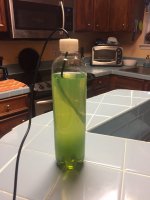The biggest issue I've had with using digital controllers is that they are only measuring ambient temps and not the contents of the keg. Air is a poor conductor of heat/cold. Plus every time you open the kezzer you are introducing warm air which impacts the ambient air but not much affect on large volumes of liquids. Thermal mass is pretty stable.
The usual method is to place the probe against the keg but you are only sortta measuring the keg temp and sortta measuring the air temp.
Putting the probe in a glass of water will fix that. But the down side of this is that the water will eventually evaporate and condense or freeze to the sides on your chamber, cause humidity issues or whatever. Or the water could even freeze while your beer is not frozen. Frozen water has air trapped inside and may not accurately represent the temperature of other liquids in the chamber that are not frozen. Or can even shatter/crack the vessel in which the water is.
My solution is to place the probe inside a bottle of water/anti freeze mix and seal the wire hole with silicone/epoxy/rubber cement/etc. This will prevent any evaporation or spillage of the liquid and if you are running your keezer near freezing your probe will not be in frozen liquid. The bottle of fluid has thermal mass, just like your keg. what ever temp the bottle is your keg is the same, unlike the ambient air inside the keezer.
The usual method is to place the probe against the keg but you are only sortta measuring the keg temp and sortta measuring the air temp.
Putting the probe in a glass of water will fix that. But the down side of this is that the water will eventually evaporate and condense or freeze to the sides on your chamber, cause humidity issues or whatever. Or the water could even freeze while your beer is not frozen. Frozen water has air trapped inside and may not accurately represent the temperature of other liquids in the chamber that are not frozen. Or can even shatter/crack the vessel in which the water is.
My solution is to place the probe inside a bottle of water/anti freeze mix and seal the wire hole with silicone/epoxy/rubber cement/etc. This will prevent any evaporation or spillage of the liquid and if you are running your keezer near freezing your probe will not be in frozen liquid. The bottle of fluid has thermal mass, just like your keg. what ever temp the bottle is your keg is the same, unlike the ambient air inside the keezer.
Attachments
Last edited:




















































![Craft A Brew - Safale S-04 Dry Yeast - Fermentis - English Ale Dry Yeast - For English and American Ales and Hard Apple Ciders - Ingredients for Home Brewing - Beer Making Supplies - [1 Pack]](https://m.media-amazon.com/images/I/41fVGNh6JfL._SL500_.jpg)







